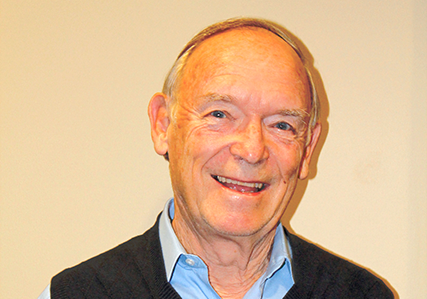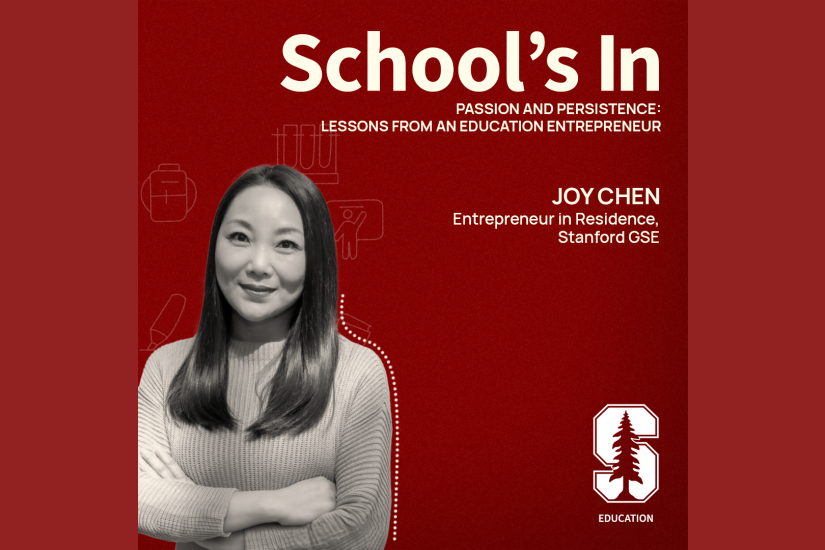
Robert Calfee, reading education scholar, dies at 81
Robert Chilton Calfee, a Stanford literacy-education expert who played a leading role in development of the LeapPad tablet used by millions of children to learn to read, died Oct. 24 at his home in Stanford, CA. The cause of death was stomach cancer. He was 81.
Calfee was professor emeritus of education at Stanford Graduate School of Education and former dean of the University of California-Riverside Graduate School of Education. An influential scholar who wrote extensively about pedagogy, he was devoted to rigorous research on the practice of teaching and then seeing that his findings had a direct impact on children’s education. This commitment led him to pioneer new approaches to training classroom teachers, to work directly with schools and to help launch LeapFrog Enterprises, Inc., which was a leader in the educational entertainment market.
Calfee became involved with the company in 1994 when Michael Wood, a Stanford alumnus who was then a lawyer, brought an early version of the company’s educational tablet to Calfee for advice. “When Bob saw my prototype, he smiled his inimitable smile, he chuckled and he said, ‘This could be fun,’” recalled Wood, the company’s founder and CEO through 2004.
The two men connected over a shared goal. “We wanted to teach kids the right way, the way great teachers taught their students,” said Wood. “We did, because every product we ever developed had a big part of Bob Calfee in it. Without Bob, there would have been no LeapFrog.”
Calfee developed the pedagogy behind the company’s first product, the LeapFrog Phonics Desk, and he would go on to recruit LeapFrog’s Educational Advisory Board and serve as its chair, providing input for the development of the company’s products.
“Bob saw vowels as the glue that hold words together. So, one of his first recommendations was to make the vowels red,” said Suzanne Barchers, former editor-in-chief and vice president at LeapFrog. “To this day, all LeapFrog products have red vowels.” The business relationship between Calfee and Barchers would blossom into a romantic relationship and, eventually, a marriage in 2007.
A True Mentor
Calfee, who earned his doctorate in psychology at UCLA, became an education professor at Stanford in 1969. He remained on the faculty of the Graduate School of Education for the next three decades, leaving in 1998 to become dean at UC-Riverside, a role he would fill until 2003.
During his career Calfee produced a remarkable body of published work; the list at the time of his death filled twenty single-spaced pages of his curriculum vitae. He likewise garnered numerous professional awards and other accolades, including a Guggenheim Fellowship in 1972, election as a Fellow of the American Association for the Advancement of Science in 1990, and the Oscar Causey Award for Outstanding Contributions to Reading Research from the National Reading Conference in 2003.
“When I was a new scholar, there weren't too many models of education researchers who applied research and theory to classroom practice. Bob did. So he became my model, my mentor and, later, my friend,” wrote P. David Pearson, professor and former dean of the Graduate School of Education at the University of California, Berkeley, on a website memorial with an online guestbook filled with comments from colleagues, students, family and friends.
As a teacher and a mentor, Calfee was known for his quiet style and gentle demeanor, but also his relentlessness as a researcher and scholar. He continued to write until his final days, even researching and editing papers from his hospital room.
“He held us to high standards of research design and analysis to uncover what actually matters in successful learning,” said Connie Juel, a professor in the Stanford Graduate School of Education who studied under Calfee, adding: “I had the sad task of returning to Stanford over 20 recently checked out library books. They were filled with Bob’s handwritten notes for an in-progress chapter.”
Lynne Baldwin, an educational psychologist who was one of Calfee’s graduate students in the 1980s, added: “Bob Calfee was special. Soft spoken and sweet, a gentleman in the truest sense. He was a lifelong mentor and a brilliant man. He taught me how to think.”
A Hardscrabble Start
Despite the many professional accolades and commercial successes, for Calfee the focus always returned to children and usually those mired in the toughest conditions for learning. He understood these kids best, perhaps because he had been one himself and knew from personal experience that education represented the surest way out of bad circumstances.
Calfee was born in Lexington, Kentucky, on January 26, 1933, the first child of Robert Klair Calfee and Nancy Bernice Stipp. Life at home was never easy and eventually Calfee and his four siblings were placed in an orphanage under the care of Lizzie Grey, a genteel southern woman who emphasized education and hard work. Despite having every reason to rebel and spiral downward, Calfee instead excelled.
Later, when his mother had remarried, she reclaimed the children and relocated the family to Los Angeles. The lessons from Grey, however, remained firmly ingrained in Calfee and continued to guide him. He would go on to attend the University of California, Los Angeles, from 1951 to 1952, then serve in the Air Force from 1953 to 1957, where he learned to repair jet engines.
“He was very good with his hands. He could fix anything,” Barchers remembered.
Calfee would eventually return to UCLA and earned his bachelor’s degree in 1959, a Master’s in 1960, and his PhD in clinical psychology in 1963. He then spent a year as a research associate at Stanford before being joining the faculty of the Department of Psychology at the University of Wisconsin, Madison, where he taught for five years before moving to Stanford.
A Champion of Practice
Calfee was no ivory tower academic, however. To him the purpose of theory was practice—teachers had to teach.
“It wasn’t just talk — I watched him do it,” said Cynthia Haven, who co-authored with Calfee the 1995 book, Teach Our Children Well (Portable Stanford Books), expounding upon his ideas for improving American education. “He'd still a boisterous classroom with a question: ‘How would you explain where you lived to a man from Mars?’ Then, he’d follow up with 'tell me more' or 'why is that?'” Haven recalled of Calfee’s command of a classroom. “And, from there, he would teach.”
Calfee believed in the inherent ability of all children to learn. “Children walking into their first classrooms vary widely in experience and temperament; but for virtually each one of them, learning is as natural as walking. Why teach them to march, when they can learn to fly?” Calfee and Haven wrote.
Out of his single-minded focus on poor performing schools, Calfee would found Project READ, a new method to train classroom teachers to be more effective at teaching reading. Project READ was aimed, first, on teaching critical literacy above basic skills and the use of language to think and to communicate. Second, it shifted away from preplanned lessons to what Calfee referred to as “responsive instruction” in which the teacher draws out lessons through inquiry and students explain their thinking.
“In the desperate communities, you will still find factory schools in place—lock, stock and barrel. The exceptions can be counted on your fingers. In our schools today, we have teachers with decades of experience in a rote model. They follow the textbooks; they do what they are told,” Calfee told a group of returning Stanford alums in 1993 during a Reunion Week course called, “Building Great Schools in Tough Places.”
As Project READ took root in reading classrooms throughout the 1980s, Calfee noticed a remarkable pattern emerge. The principles instilled through the program started to spread beyond the classroom to the entire school. The schools became, in Calfee’s words, “communities of inquiry.” Out of this trend, arose the Inquiring Schools effort that implemented critical literacy skills throughout the school community. Today, there are numerous Calfee-inspired “Schools of Inquiry” across the country.
“I would say we were learners together, and together we learned how to improve education for children in some pretty tough circumstances,” said Ramon Cortines, current superintendent of the Los Angeles Unified School District, who worked with Calfee frequently over the decades when Cortines was superintendent in San Jose and in San Francisco.
“He was always there, observing, working with me, guiding me, the perfect blend of theoretician and practical teacher,” Cortines said.
Calfee is survived by his wife, Suzanne Barchers of Stanford, CA; three children: Adele (Calfee) Woodward of San Dimas, CA; Robert W. Calfee of Dublin, CA, and Elise Sachs of Boulder, CO; and four grandchildren. Calfee also has three surviving sisters: Sara (Calfee) Goodno of Pasadena, CA, Jean (Calfee) Knapp of Covina, CA, and Loretta Calfee, San Diego, CA. He is preceded in death by his brother James Lee Calfee; a son, Robert Allen Calfee; and his previous wife, Nel Little. His previous marriages ended in divorce.
A memorial service is planned Dec. 6 at 1 p.m. at the Valley Presbyterian Church, 945 Portola Road, Portola Valley, CA 94028, followed by a drop-in reception from 3:00-5:00 p.m. at the Barchers-Calfee residence.
In lieu of flowers, the family requests that memorial donations be made to a previously established student fellowship fund at UC-Riverside by visiting http://bit.ly/10yOjEo and entering “Calfee” in the search.
Andrew Myers is a writer and editor who frequently contributes to Stanford Graduate School of Education's website and publications.



